Biography of Maria Domenica Brun Barbantini
IN THE TEACHINGS OF LOVE
Maria Domenica was born on January 17, 1789, in Lucca, Italy. Her father, Pietro Brun, a native from Lucerne, Switzerland, served in the Swiss Guards stationed in Lucca; her mother, Joan Granucci, was a native of Pariana, a small town in the province of Lucca.
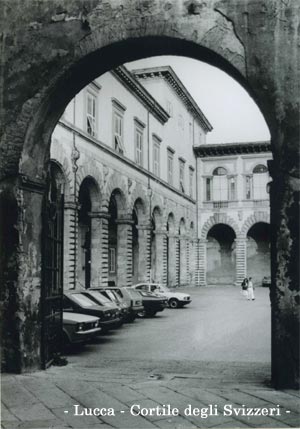
The Brun family lived modestly. The wages of the Swiss Guards were not high, however, they were privileged to live in a quarter in the Ducal Palace.
There is very little information about Maria Domenica’s father, Peter Brun. Her mother, Joan, appears to be a wise woman, full of initiative, able to take care of the family even after the premature death of her husband.
Years of Adoloscence
Maria Domenica has an open personality and intelligence. She spent her early childhood happily in the care of her mother and her father’s rigid, military-style, upbringing. The official biographies write about her special devotion to the Blessed Virgin Mary. Indeed, they also mention a particular incident that supposedly happened during the celebration of the Mass, where Maria Domenica attended, in the “Chiesa di Miracoli” (in front of the Ducal Palace); during the consecration, Maria Domenica saw the Precious Blood overflow from the chalice elevated by the priest. She was overwhelmed with emotion; strong character as she, however, did not reveal the incident to anyone, aside from her confessor. Since then, she became even more docile and virtuous.
Her childhood was “ordinary.” Her adolescence was, instead, marked by pain; her father and three siblings died within a short distance from each other.
Her father’s death seems to touch her in a particular way, evident in her emotion and affective development. There is no trace of him in her later writings, as though it will remain a “secret” memory in her heart. Three years after her father’s death, Maria Domenica has had a psychological crisis, which manage to come out presumably due to the firm education, she received during her childhood, and with the help of her mother’s patient guidance. Maria Domenica overcomes the state of grief and enters her youth full of dreams and hopes, engaged in the humanities and religious studies, common among the middle-class bourgeois of her time and place.
Until about fifteen years old, Maria Domenica seems to embrace an austere life, devoted to her study, alienated from the pleasures of youth. Then her lifestyle begins to change. She has become a very attractive young woman and has plenty of suitors and admirers.
Young spouse
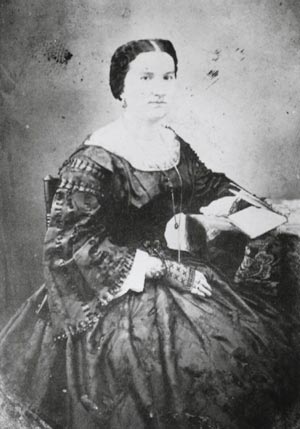
At the age of eighteen, Maria Domenica was asked to marry Salvatore Barbantini, a good young man from Lucca, well-to-do but not rich. Salvatore had inherited a fabric store from his father. Giovanna, Maria Domenica’s mother, who knows about Barbantini’s financial situation, is not happy about this marriage; she would like her daughter to have a more secure position. The two young people love each other tenderly: the “tug of war” between Maria Domenica and her mother lasts four years, but in the end, she wins her battle: on April 22, 1811, in the cathedral of St. Martin in Lucca, Maria Domenica marries Salvatore.
God’s plans for Maria Domenica, however, are different from what might appear to be the happy outcome of a romantic story. Just five months after the wedding, the “adored bridegroom” suddenly dies, tragically leaving Maria Domenica alone, already expecting a child.
Faced with the painful ordeal, the 22-year-old widow wept, but she did not let herself be taken by despair: her strong character and deep faith in divine mercy sustained her. On the very night of the tragedy, she kneels before the Crucifix and, embracing it, declares her acceptance of the Father’s will with these words: “Oh my God… God of my heart… you have severely beaten me… you alone, my Crucified, my good, will be from now on the sweetest spouse of my soul… my only love, my eternal portion”. A full, total, and irrevocable consecration born from the ashes of untimely mourning and a feeling of immense and cruel sorrow, enlightened however by a living faith, by hope without boundaries, by an immense love for the Lord.
Beginning of a “heroic” life
After the death of Salvatore, Maria Domenica always wore a simple black dress which symbolizes, in a certain sense, the austerity of her interior life. She is still very young and could remarry, but she refuses every proposal because she wants to dedicate herself solely to the son who is about to be born and to the works of mercy that the Lord will gradually show her.
On February 14, 1812, Lorenzo Pietro was born. Lorenzino, as his mother affectionately called him. From that moment on, Maria Domenica lived only for her son. Her economic conditions are not very good: Salvatore, at his death, had left her little property. As Maria Domenica herself wrote in her autobiography, she made every possible sacrifice to make her son’s life as secure as possible.
In the meantime, Lorenzino gave joy to his mother: Maria Domenica affirms, in the autobiography, that the little boy seemed to have been endowed by the Lord with many admirable qualities in body and soul as if to compensate her in part for the tragic death of her husband. As the little boy grew up, he showed a keen sense of discernment, an extraordinary passion for studies… Already at the age of four, aided by an exceptional memory, Lorenzino was able to correctly answer the questions he was asked about the Holy Scriptures. At the age of seven, he wrote correctly in Latin and knew a little French…
In the meantime, another «love» was born in Maria Domenica’s heart: the love for poor and sick women, who lacked any kind of assistance. Although caring for her son took up her entire day, Maria Domenica managed to take care of these poor women, heroically dedicating a few hours of the night to assisting them in their homes.
But another trial awaited the young widow: Lorenzino, the beloved son who was her only consolation, died almost suddenly, struck by a serious illness, at the age of eight.
The poor mother is distraught: «I don’t know how I didn’t lose my sanity», she writes, and while her heart is weeping tears of blood, once again she transforms that unspeakable drama into an offering: «I looked at the sky – she says – and oppressed by grief, I repeated the offering of that only beloved son and my excessive sorrow».
Offering to the sick
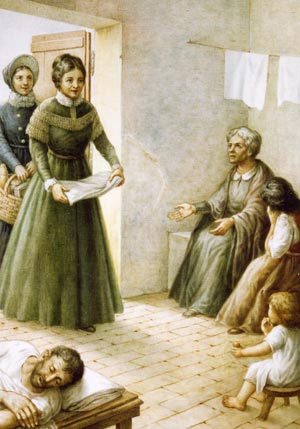
Two love stories have tragically and prematurely broken. One might expect a desperate reaction, a rebellion against the cruelty of destiny, even against God… Maria Domenica did not fall into this terrible temptation, and she channeled the river of love within her soul towards God “incarnate” in the poor people she met. From now on, her heart will burn with love, tenderness, and care for the poor and lonely sick, for the abandoned, for the dying.
By day and by night, under the scorching sun or the pouring rain, she walked, with her lantern-lit, through the narrow and dark streets of the city of Lucca to go to the bedside of the most serious and lonely infirm. One night, assailed by a hurricane, her light goes out; groping for a long time in the dark, she finally arrives at the desired place and, with her clothes soaked in water, she carries out assistance for the whole night, not caring at all about herself but about Jesus, present “in the sick body” of that sick person.
Often, after a whole night of service, she let the day pass without taking food. Sometimes, assailed by a terrible sleep, while assisting, she goes so far as to put tobacco in her eyes; this remedy causes her great suffering, but it is effective in keeping her awake and not depriving the sick of her help and comfort.
Not everyone welcomed her merciful work: it is said that someone put soap on the steps that Maria Domenica had to climb to reach a sick person, to cause her to slip and fall. She noted that perhaps the devil, irritated by the losses incurred by her work of assistance not only to bodies but also to souls, tried in every way to hinder her.
Sometimes, while she moves in the middle of the night in the dark and precarious streets of the outskirts of the city, she is pursued by unknown ill-intentioned people; a strong and courageous woman, she is not intimidated by anyone; she has a flame in her heart that nothing and no one can extinguish.
And she does not only take care of body and soul: she often leaves – she as poor as she is – what little she can in money to the sick to alleviate their misery.
Two love stories have tragically and prematurely broken. One might expect a desperate reaction, a rebellion against the cruelty of destiny, even against God… Maria Domenica did not fall into this terrible temptation, and she channeled the river of love within her soul towards God “incarnate” in the poor people she met. From now on, her heart will burn with love, tenderness, and care for the poor and lonely sick, for the abandoned, for the dying.
By day and by night, under the scorching sun or the pouring rain, she walked, with her lantern-lit, through the narrow and dark streets of the city of Lucca to go to the bedside of the most serious and lonely infirm. One night, assailed by a hurricane, her light goes out; groping for a long time in the dark, she finally arrives at the desired place and, with her clothes soaked in water, she carries out assistance for the whole night, not caring at all about herself but about Jesus, present “in the sick body” of that sick person.
Often, after a whole night of service, she let the day pass without taking food. Sometimes, assailed by a terrible sleep, while assisting, she goes so far as to put tobacco in her eyes; this remedy causes her great suffering, but it is effective in keeping her awake and not depriving the sick of her help and comfort.
Not everyone welcomed her merciful work: it is said that someone put soap on the steps that Maria Domenica had to climb to reach a sick person, to cause her to slip and fall. She noted that perhaps the devil, irritated by the losses incurred by her work of assistance not only to bodies but also to souls, tried in every way to hinder her.
Sometimes, while she moves in the middle of the night in the dark and precarious streets of the outskirts of the city, she is pursued by unknown ill-intentioned people; a strong and courageous woman, she is not intimidated by anyone; she has a flame in her heart that nothing and no one can extinguish.
And she does not only take care of body and soul: she often leaves – she as poor as she is – what little she can in money to the sick to alleviate their misery.
“Fioretti” of Maria Domenica
During this period of the life of Maria Domenica are told some “Fioretti”. One day she put on the body of a poor pregnant woman, who seemed about to die, a flower taken from the altar on which the Blessed Sacrament was exposed. The woman gave birth to twins and recovered her health.
Another sick woman could not feed her newborn. Maria Domenica prays to the Blessed Virgin venerated at the altar of a church familiar to her. At the end of the prayer, Brun Barbantini runs to the woman, tells her to pray to Our Lady and to take the baby to her breast. The woman obeys and, to her surprise, can feed her baby.
To another sick woman, worried to leave her little girl an orphan, Maria Domenica says not to be afraid: «I promise you that when God calls you, I will take care of your daughter and be her mother» …
Maria Domenica obeys her heart. From the moment of her radical existential change, Jesus and the sick become the life of her life, with total dedication. She is “the Good Samaritan” who does not care for herself but only for those who need her, overcoming all repugnance and all human respect.
It is the simple “charism” that one day she will transmit to the young women who will follow her on this path of love without reserve. They will have to overcome repugnance, to seek God in the homes of the poor, often more malodorous than stables, on their bodies ravaged by sores and ulcers. «It is where the air is tainted with stench, where all sort of insects is the sole company of the unfortunate sufferer, it is there, I say, where God often wants to be found and served…».
The Ministers of the Infirm
As time went by, Maria Domenica realized that she could not deal on her own with the world of the sick, which appeared to her to be increasingly vast. She, thus, began to think of a new form of assistance that would embrace the field of charity. As she writes in 1817, there already existed in Lucca a small congregation of women religious whose purpose was to assist the sick who were not accepted in hospitals and families who had fallen into poverty and did not dare to bring their loved ones to the hospital.
Her organizational skills and practical intelligence led her to form a group of evangelically inspired women who committed themselves to care for the sick poor. A small group for an enormous purpose: but, after all, all great works of charity begin this way! And that small group is also the strong root from which one day the Ministers of the Infirm will be born.
It is 1819: the “Pious Union of the Sisters of Charity” is born, immediately placed under the high patronage of Our Lady of Sorrows. Archbishop Sardi officially approves the “Pious Union” for which another holy priest, Monsignor Del Prete, confessor and spiritual father of Maria Domenica, writes some “rules”.
Brun Barbantini’s life is about to take a new turn. Monsignor Del Prete entrusted her with two women, very devout, who wanted to “leave the world” to live together, in community, “devoting themselves to prayer and the apostolate”. They needed a home to live in. Del Prete told Maria Domenica about this and asked her to “cooperate for the glory of God” by buying the house where the two “postulants” could live.
This is also the beginning of new work: the foundation of the Oblates of St. Francis de Sales.
Foundation of the Visitation Monastery in Lucca
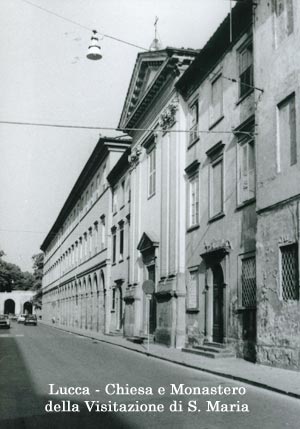
The richness of the human and spiritual gifts of the young widow Barbantini, including intelligence, creativity, courage, and initiative, certainly do not escape the attention of the archbishop and the clergy of her city. After the two first “foundations” they entrusted her with the task of establishing in Lucca a “Monastery of the Visitation” for the education of youth.
Maria Domenica, docile to the voice of the pastors and sensitive to the demands of the Church, accepted the commitment with generosity and determination.
Her love for the Lord makes her once again capable of facing every difficulty. After about six years of intense work marked by obstacles, she succeeds in giving the city of Lucca the desired monastery, which still exists today and is rich in spiritual and apostolic vitality.
The new Institute for the sick
Once the work of the Visitation was completed, Maria Domenica’s authentic “vocation” emerged, bursting forth, that which she felt truly called by the Lord: to found a religious Congregation of Oblate Nursing Sisters to serve Christ in the sick and suffering, full-time and for life.
On January 23, 1829, Maria Domenica initiated the first community of Oblate Nursing Sisters. Poor and in poor health, but rich in zeal and love for Christ, the Foundress and the first Sisters performed authentic prodigies of charity at the bedside of the sick and dying, in poor dwellings, where even the dying lay alone and abandoned.
Maria Domenica and the other women who joined her in the meantime had only one ideal, as she specifies in her Rules: “To visit, assist and serve the human God agonizing in the garden or breathing on the cross in the persons of the poor and dying infirm”. And all this “with a heart ablaze with the charity of Christ”.
Maria Domenica also teaches her “daughters in the Spirit” that their vocation involves the total gift of the person in “serving the sick, even at the risk of one’s life”. For this reason, in the Rules, she asks her daughters to be willing to commit martyrdom: “They will serve Our Lord Jesus Christ in the persons of the sick with generosity and purity of intention, always ready to lay down their lives for love of Christ who died on a cross for us.
The witness of evangelical charity of Barbantini and her disciples led Monsignor Domenico Stefanelli, Archbishop of Lucca, to approve – finally – the Rules and the Institute of Maria Domenica. This happened on August 5, 1841. The Congregation of the Ministers of the Infirm was born.
Our Lady of Sorrows and St. Camillus de Lellis

Maria Domenica entrusted to Our Lady of Sorrows the protection and guidance of her Institute and expressly called her “Our Superior”.
The Mother of Sorrows is indicated by her as the inspirational icon of the Congregation’s mission. Just as the Mother of Jesus assists her crucified son and shares his pain, torment, and abandonment, so Maria Domenica invites her daughters to live “compassion” alongside the sick and suffering of every age.
Maria Domenica made another decisive encounter: the one with Saint Camillus de Lellis. She met the first Camillian when his ministry was taking its first steps. It is an encounter of fundamental importance: Father Antonio Scalabrini sees in Barbantini’s charism the singular similarities with that of its founder, St. Camillus de Lellis. He encouraged her and promised her help in her difficulties.
On March 23, 1852, Pius IX conferred on the institute the Decretum Laudis, the pontifical document through which he granted the daughters of Maria Domenica the name of “Ministers of the Sick” and officially decreed the spiritual communion between the Order of Camillian religious and the Congregation of Maria Domenica.
The Foundress and her daughters ardently desired to wear the red cross of St. Camillus. This desire, for a long time unfulfilled, was fulfilled in August 1855, when cholera was still claiming victims throughout Tuscany, and the daughters of Maria Domenica left the city of Lucca for the first time to go and care for the cholera victims in the lazarettos of nearby cities, marked in their habit by the red cross.
All good, then, all easy? Not for Maria Domenica who has to face accusations, backbiting, and perhaps envy. There is a misunderstanding between her and Archbishop Giulio Arrigoni, who is an intelligent and open person. She even has to face a trial. And as usual, she will find shelter in her usual refuge: HUMILITY.
The last years
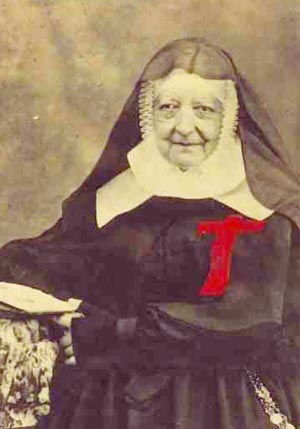
Maria Domenica’s strength gradually diminished. In 1866 she fell seriously ill, but managed to overcome her illness, thanks – it is said – to the intercession of Saint Camillus de Lellis. She still took an active interest in her congregation but realized that her strength was diminishing every day and that life was about to leave her.
With this premonition, she makes sure to leave “everything in order”. She did not want her daughters to have to worry about anything, even from a practical point of view (Maria Domenica had always been a woman “with her feet on the ground”).
In this period her prayer becomes more intense. She has some serious concerns about the future of her Institute. These are the times in which a united Italy is taking shape and in which an anti-clerical and hostile wave to religious congregations is rising.
The approach of the end seems to provoke also a change in her somatic features: her face swells, but the sweetness of her expression and the transparency of her gaze remain intact. These changes are also testified by the photographic portraits (photography had just been invented) that were taken of her.
Maria Domenica was weakened by an illness of which, however, there was no precise diagnosis, an illness that would make her suffer until the last moment and of which she would say: “This is the way I must die”.
This happened on May 22, 1868. Mother Maria Domenica Brun Barbantini left the Institute small in number, but strong in spirit and generous in its service to the sick.
Maria Domenica “blessed”
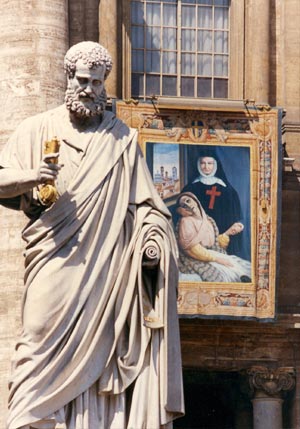
During her long life, Maria Domenica had sought only “the will of God and his greater glory”. In her journey of holiness, she had tasted the joys of so much love and the bitterness of calumny, which she had accepted by “praying, forgiving, and loving her persecutors.” She dedicated every moment of her time and every moment of her labors to the spiritual and charismatic formation of her daughters whom the Spirit had entrusted to her.
On May 7, 1995, in St. Peter’s Square in Rome, John Paul II solemnly proclaimed Maria Domenica Brun Barbantini “Blessed”, indicating her to the world as an authentic witness “of a concrete evangelical love for the last, the marginalized, and the wounded; a love made up of gestures, of attention, of Christian consolation, of generous dedication, and untiring closeness to the sick and the suffering”.
